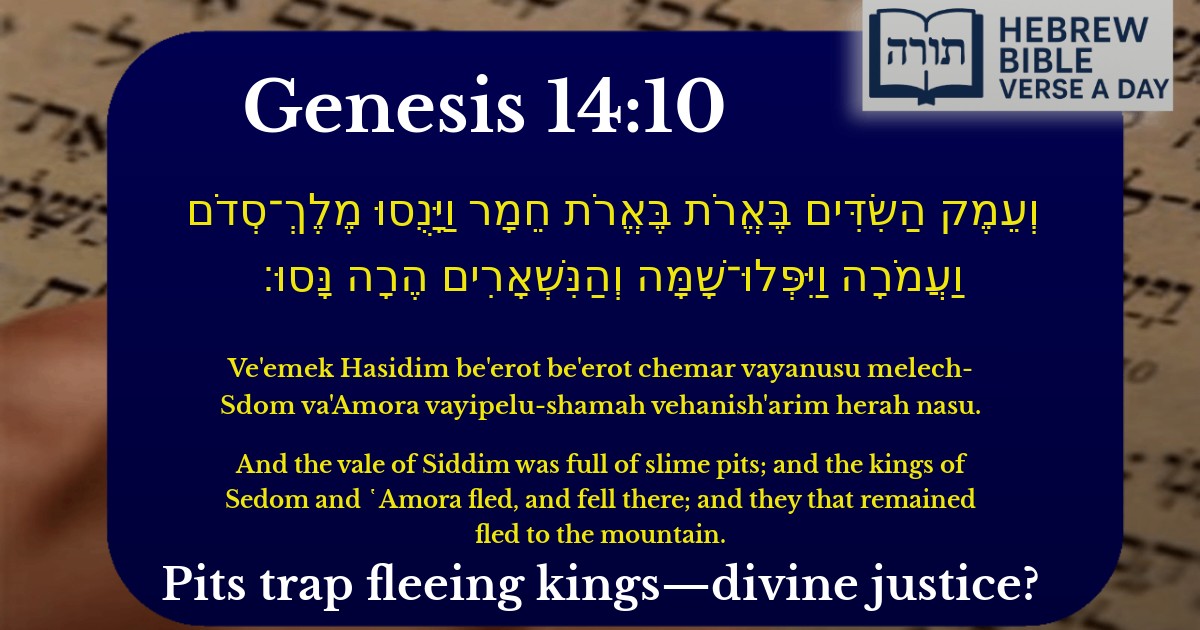Join Our Newsletter To Be Informed When New Videos Are Posted
Join the thousands of fellow Studends who rely on our videos to learn how to read the bible in Hebrew for free!
Hebrew Text
וְעֵמֶק הַשִׂדִּים בֶּאֱרֹת בֶּאֱרֹת חֵמָר וַיָּנֻסוּ מֶלֶךְ־סְדֹם וַעֲמֹרָה וַיִּפְּלוּ־שָׁמָּה וְהַנִּשְׁאָרִים הֶרָה נָּסוּ׃
English Translation
And the vale of Siddim was full of slime pits; and the kings of Sedom and ῾Amora fled, and fell there; and they that remained fled to the mountain.
Transliteration
Ve'emek Hasidim be'erot be'erot chemar vayanusu melech-Sdom va'Amora vayipelu-shamah vehanish'arim herah nasu.
Hebrew Leining Text
וְעֵ֣מֶק הַשִּׂדִּ֗ים בֶּֽאֱרֹ֤ת בֶּאֱרֹת֙ חֵמָ֔ר וַיָּנֻ֛סוּ מֶֽלֶךְ־סְדֹ֥ם וַעֲמֹרָ֖ה וַיִּפְּלוּ־שָׁ֑מָּה וְהַנִּשְׁאָרִ֖ים הֶ֥רָה נָּֽסוּ׃


Geographical and Historical Context
The verse describes the aftermath of the battle between the four kings and the five kings in Bereshit 14:10. The Emek HaSiddim (Vale of Siddim) was known for its be'erot chemar (slime pits), which Rashi explains were pits of sticky clay or bitumen (a natural tar-like substance). This region was later submerged under the Dead Sea after the destruction of Sedom and Amorah, as mentioned in Bereshit 14:3.
Interpretation of the Slime Pits
Ramban (Nachmanides) notes that the presence of these pits was a significant factor in the battle's outcome. The kings of Sedom and Amorah attempted to flee but became trapped in the pits, leading to their downfall. The Malbim adds that this was a measure-for-measure punishment—just as the people of Sedom were morally "stuck" in their wickedness (as described in later verses), they were now physically stuck in the slime pits.
The Fate of the Kings
Rashi explains that "they fell there" refers to those who died in the pits, while "the survivors fled to the mountain" suggests that some escaped to higher ground. The Ibn Ezra connects this to the later rescue of Lot, who was taken captive but saved by Avraham (as described in the following verses). The mountain may symbolize a place of refuge, contrasting with the doomed valley below.
Midrashic Insights
Moral Lessons
The Sforno teaches that this event foreshadows the eventual destruction of Sedom and Amorah—their initial stumble in the slime pits was a precursor to their complete downfall due to their corruption. The Kli Yakar emphasizes that those who rely on physical strength (like the kings) are ultimately vulnerable, while true salvation comes from righteousness, as seen in Avraham's later intervention.